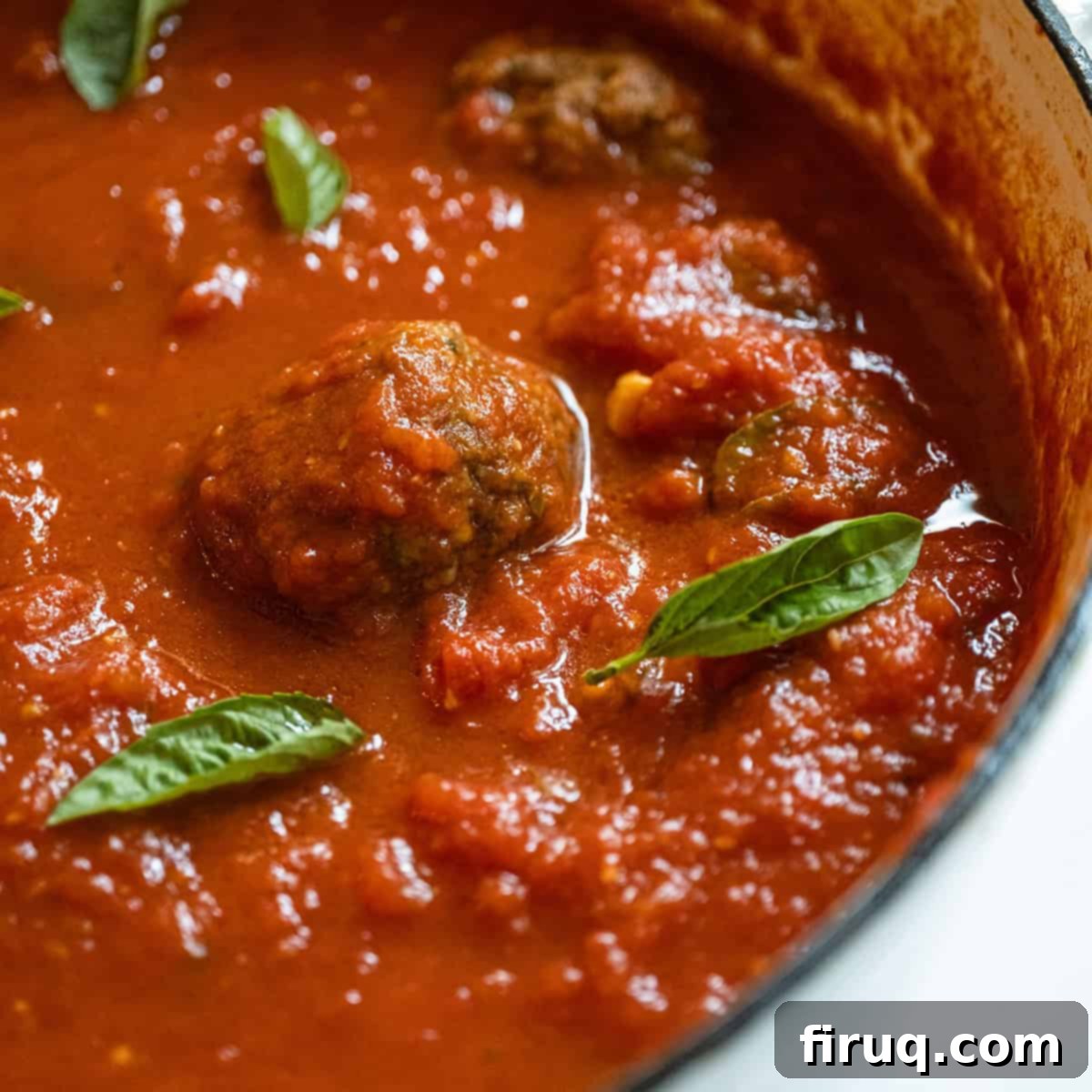Authentic Italian Sunday Sauce: The Ultimate Family Recipe for a Hearty Meal
Forget what you think you know about elaborate secrets to an Authentic Italian Sunday Sauce. There’s no magical incantation or hidden technique that only a nonna can impart. I’m here to demystify this beloved culinary tradition and share my straightforward, yet incredibly flavorful, Sunday sauce recipe. The real “secret” lies in embracing simple, high-quality ingredients and granting them the most precious gift of all: time. A long, patient simmer is truly the cornerstone of this deeply nostalgic and comforting dish.
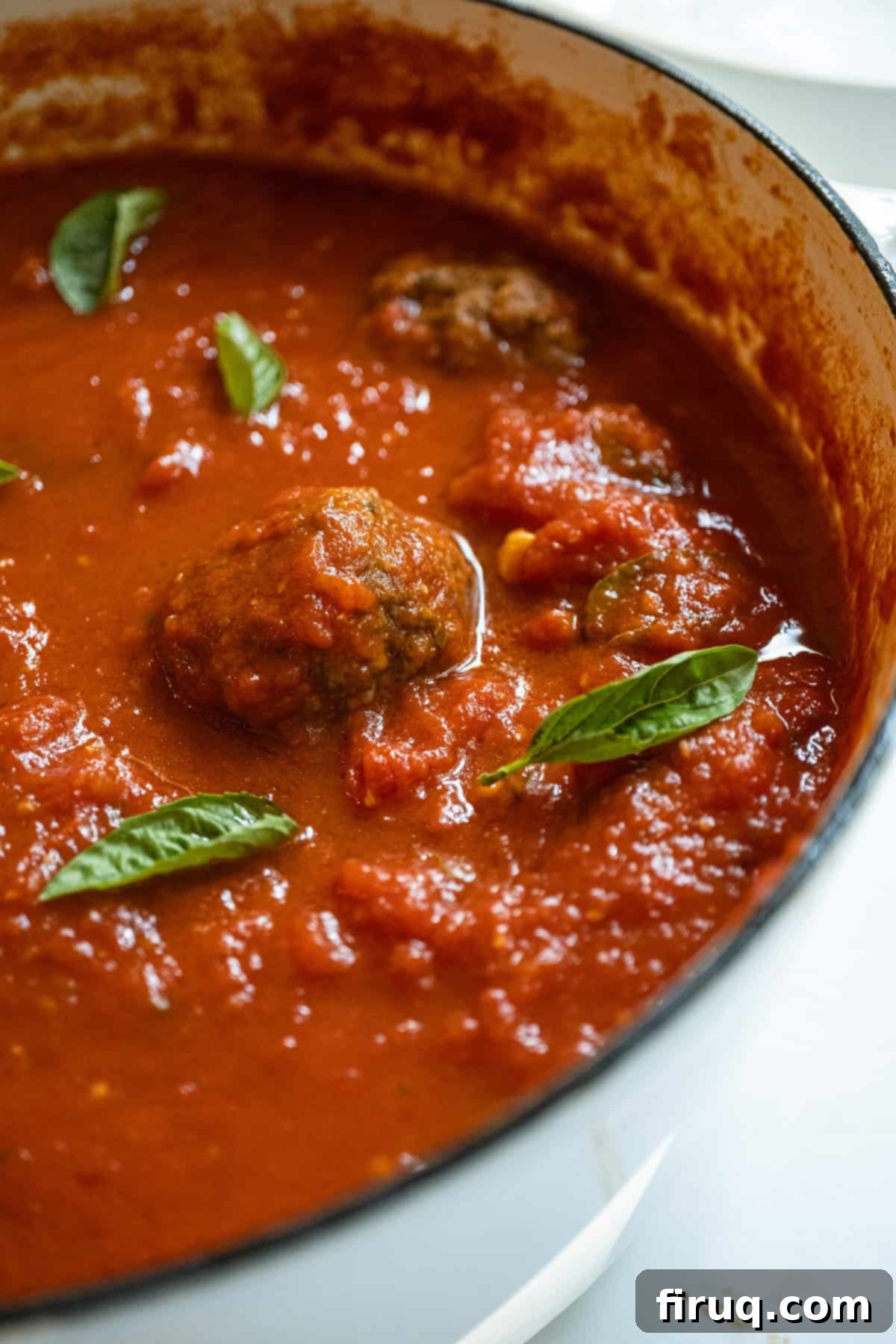
If you cherish the tradition of all-day Sunday cooking, you might also enjoy my Bison Ragu or my Authentic Bolognese!
The True Essence of Sunday Sauce: More Than Just a Recipe
Everyone believes their family makes the best Authentic Italian Sunday Sauce, and honestly, they’re probably right. I won’t claim my recipe surpasses your Nonna’s or your mom’s, because taste is inherently tied to memory and emotion. The truth is, the Sunday sauce you grew up with will always hold a special place in your heart. However, when you dedicate an entire day to slow-cooking, you want the result to be nothing short of delicious. Hearty, braised dishes like this Sunday Sauce, or a rich Bison Ragu, embody the spirit of a perfect Sunday meal.
Beyond the simple ingredients and rich flavors, Sunday Sauce is deeply intertwined with nostalgia and family tradition. It evokes memories of bustling Sunday afternoons: the comforting aroma filling the house, laughter echoing around the dinner table, Grandpa playfully demanding dessert, Grandma’s lively gossip about the neighbors, or animated debates between parents about whether you should fry or bake meatballs. These are the moments that truly define Sunday Sauce.
My goal is to guide you in crafting your own signature Sunday Sauce recipe – one that will become a beloved tradition for your family for generations to come. By understanding each step and the role of every ingredient, you can truly master this classic. Dive into the detailed explanations below to perfect your technique. If you’re looking for a quicker, yet equally delicious, alternative, be sure to check out The Ultimate Guide to Marinara Sauce for a simple and flavorful option that’s ready in less time.
Ingredient Notes and Expert Tips for Your Sunday Sauce
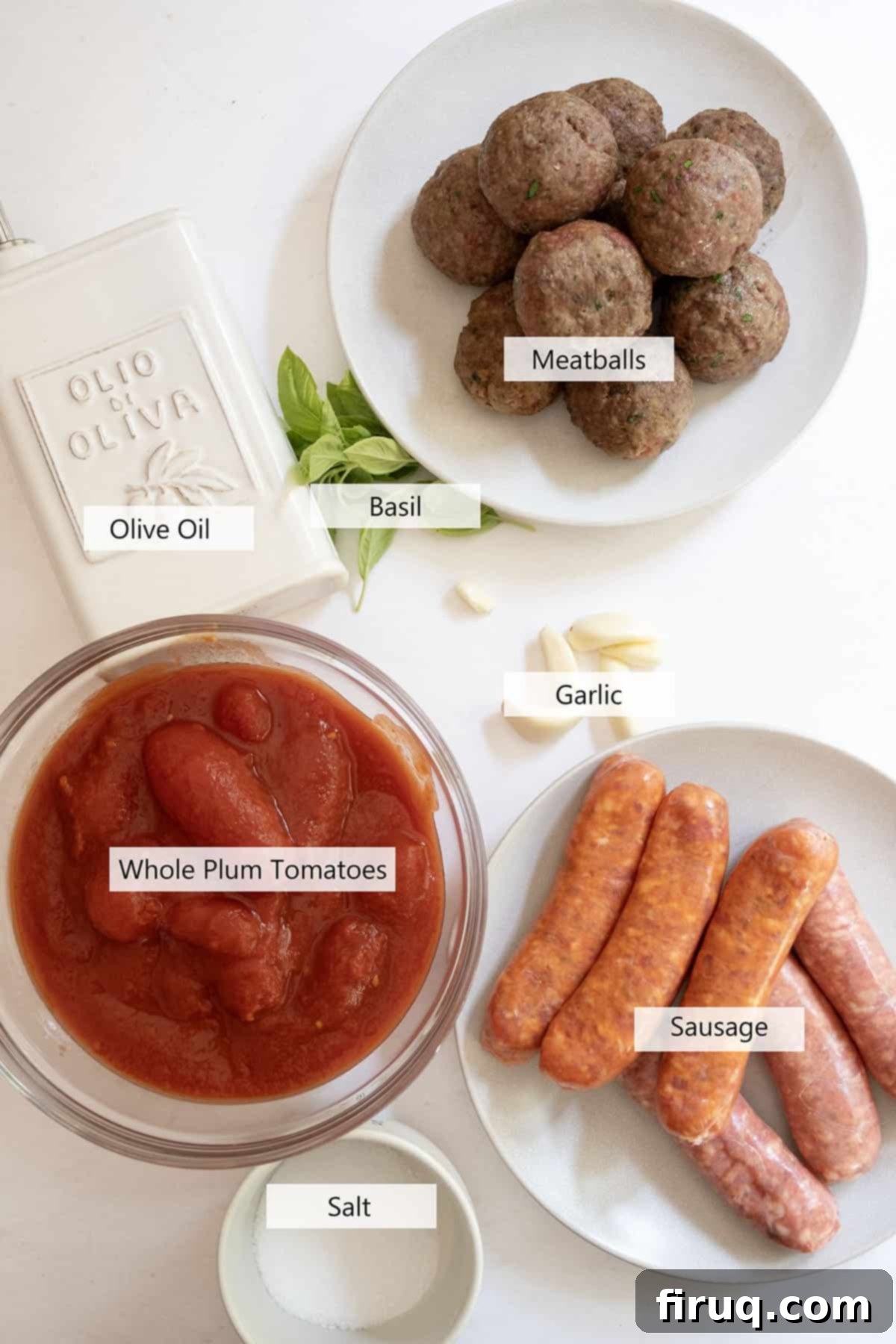
- Garlic. The cornerstone of any good Italian sauce! Always opt for fresh garlic cloves. Pre-minced or jarred garlic often contains additives that can impart an unpleasant, chemical taste to your slow-cooked sauce. The moment you slice fresh garlic, its membranes break, releasing those aromatic compounds we love. The longer it sits, the more pungent and sometimes bitter it can become, so using fresh and preparing it just before cooking is ideal for the best flavor.
- Extra Virgin Olive Oil. As a foundational ingredient, the quality of your olive oil truly matters. Look for a high-quality, cold-pressed extra virgin olive oil. Ideally, one where you can trace its origin or know it’s made from a single type of olive. This ensures a pure, fruity, and slightly peppery flavor that enhances, rather than competes with, the other ingredients.
- Tomato Paste. This concentrated tomato goodness is crucial for depth. Sautéing tomato paste before adding other liquids allows it to caramelize. This process develops richer, sweeter, and more complex umami flavors, transforming its raw acidity into a foundational sweetness for your sauce. It’s a vital step for a truly authentic taste.
- Whole Plum Tomatoes. For the best texture and flavor, I highly recommend using canned San Marzano tomatoes. These D.O.P. certified tomatoes from the Sarno Valley in Italy are known for their sweet, balanced flavor, lower acidity, and tender flesh. Brands like Cento or Nina are consistently excellent choices. My mom always swore by Tuttoroso, a testament to personal preference and regional availability. Avoid crushed or diced tomatoes if you can, as their processing often means a loss of fresh flavor and texture.
- Basil. Fresh basil is non-negotiable for this recipe. Its bright, aromatic notes elevate the sauce considerably. My tip is to stir in half of your fresh basil at the beginning of the cooking process to infuse its essence throughout the sauce, and save the remaining half to stir in at the very end. This final addition provides a vibrant burst of fresh basil flavor that truly brightens the entire dish.
- Salt. Seasoning is an art, not a science, especially with a slow-simmered sauce. I advocate for slowly adding kosher salt throughout the cooking process. Taste the sauce periodically – every hour or so – and adjust as needed. The flavors will concentrate and deepen over time, and the sauce will absorb more salt. This gradual approach ensures perfect seasoning without over-salting.
- Meat. The heart of Sunday Sauce! The meats braised in the sauce contribute immensely to its rich flavor profile.
- Classic Italian Fried Meatballs are a staple in almost every batch of Sunday Sauce I make. Their savory richness perfectly complements the tomato base.
- Italian Sausage is my second favorite addition. I often prepare my own using my How to Make Homemade Italian Sausage recipe, allowing me to customize the flavor. You can choose hot, sweet, or a combination.
- For an even deeper flavor, consider adding other braising meats like neckbones, short ribs, or pork ribs. I particularly love making Italian Short Ribs to enrich my Sunday Sauce.
- On special occasions or holidays, I enjoy adding Authentic Italian Braciole. This rolled flank steak becomes incredibly tender and flavorful as it slowly cooks in the sauce.
- Additions: Parmigiano Rind. If available, I always toss a Parmigiano-Reggiano rind into the simmering sauce. As it cooks, the rind slowly melts and releases a wonderful depth of umami, adding a subtle pungent and nutty flavor that enriches the sauce without overpowering it. Just remember to remove it before serving!
Remember, the beauty of Sunday Sauce is making it your own. Experiment with these ingredients and techniques to develop a recipe that speaks to you and becomes a cherished tradition for your family!
*Please refer to the recipe card below for precise measurements and additional ingredient information.
How to Make an Authentic Italian Sunday Sauce: Step-by-Step Guide
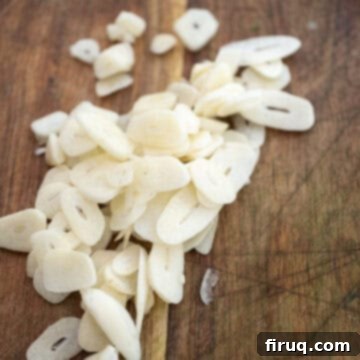
Step 1: Prepare the Garlic. Begin by slicing your fresh garlic as thin as possible. Consistency in slicing is key to ensure the garlic cooks evenly and infuses its flavor without burning. This careful preparation prevents any harsh, bitter notes from developing.
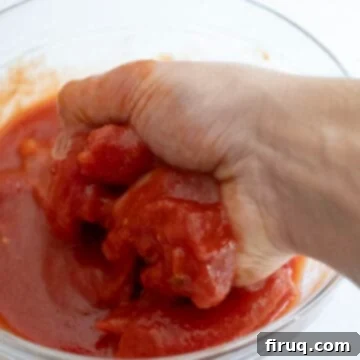
Step 2: Hand-Crush Tomatoes. Empty your cans of San Marzano tomatoes into a large bowl and hand-crush them. This method gives you better control over the texture compared to a blender, leaving some delightful chunks while releasing their juices for the sauce. This is a messy but rewarding step!

Step 3: Sear Your Meats. In the large pot you’ll use for the sauce, begin to sear or par-fry your chosen meats – whether it’s meatballs, Italian sausages, or other cuts like short ribs. Searing creates a beautiful brown crust (the Maillard reaction) that locks in flavor and adds a deeper savory note to the sauce. Once browned, remove the meats and set them aside. For meatballs, par-frying is common, while sausages can be seared or even boiled depending on their preparation.
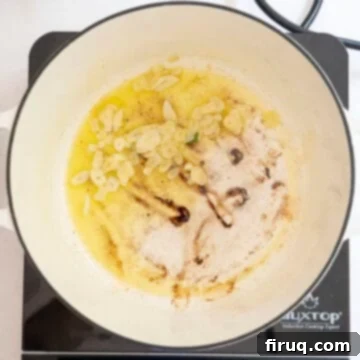
Step 4: Sauté the Garlic. Using the same pot (which now holds flavorful fond from the seared meats), heat your extra virgin olive oil over medium heat. Once shimmering, add the sliced garlic. Stir continuously for approximately 1 minute. The goal is to gently soften and perfume the oil, not to brown or burn the garlic, which can quickly turn bitter.
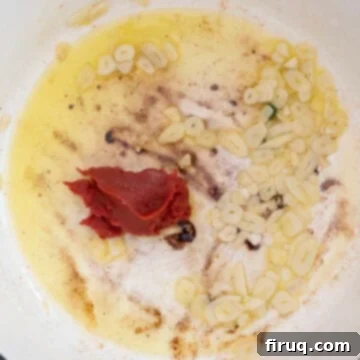
Step 5: Caramelize the Tomato Paste. After the garlic has softened for a minute, push it to one side of the pot and add the tomato paste directly to the hot pan surface. Let the tomato paste cook undisturbed for about a minute to allow it to begin to caramelize and deepen in color. Continue stirring the garlic separately, then combine the garlic and tomato paste, stirring constantly for another minute or two until the paste takes on a rich, brick-red hue. This step is vital for developing its inherent sweetness and complex flavor.
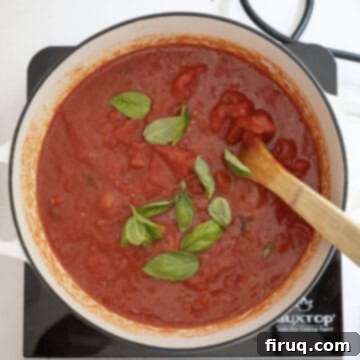
Step 6: Introduce Tomatoes, Basil, and Initial Seasoning. Pour in your hand-crushed San Marzano tomatoes. Stir in half of the fresh basil leaves and approximately ½ teaspoon of salt. Bring the sauce to a gentle simmer, stirring occasionally to ensure even heating and to help break down the tomatoes further. This initial simmer allows the flavors to begin melding.
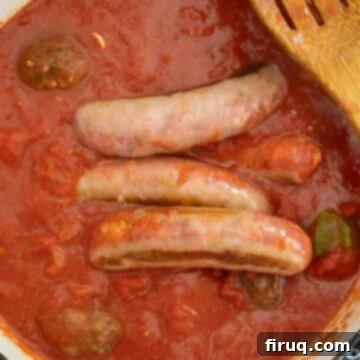
Step 7: The Long Simmer. Once the sauce is gently simmering, carefully add your seared meats back into the pot. If you’re using a Parmigiano rind, now is the time to add it too. Cover the pot, reduce the heat to low, and allow the sauce to simmer for a minimum of 3 hours. This long, slow cooking process is where the magic happens; flavors deepen, meld, and the tomatoes lose their raw edge, becoming wonderfully rich and mellow. Remember to stir the sauce every 30-45 minutes to prevent it from sticking to the bottom, and taste often, adjusting the salt as needed – the sauce will require more salt as it concentrates.
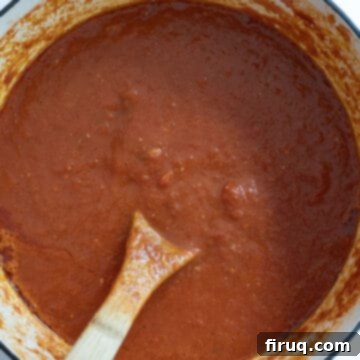
Step 8: Final Touches and Serving. Once your sauce has reached its desired richness and thickness after the long simmer, carefully remove all the meats (including the Parmigiano rind if used). At this point, I personally like to slightly blend my sauce with an immersion blender to achieve a smoother consistency, leaving a few rustic chunks. However, my wife prefers a slightly chunkier texture, so feel free to adjust to your family’s preference.
After your Sunday Sauce is perfect, it’s time for the pasta! Boil your favorite pasta shape until al dente. Drain the pasta and immediately return it to the hot pot. Add a generous amount of your freshly made sauce directly into the pot with the pasta and stir vigorously while the pasta is still hot. This crucial step ensures the pasta fully absorbs some of that magnificent sauce, resulting in a more flavorful and integrated dish. Serve immediately with extra sauce, the braised meats, and a sprinkle of fresh grated Parmigiano-Reggiano.
Pro Tips for the Best Authentic Italian Sunday Sauce!
- The true secret to an Authentic Italian Sunday Sauce is simply time and patience. Tomatoes require a long, slow cook to shed their raw acidity and develop their full, sweet, and complex flavors. Don’t rush this essential step!
- Stir often to prevent the sauce from sticking and burning at the bottom of the pot. A scorched bottom can ruin the entire batch, and as I learned from my mom, the wrath for forgetting to stir is something fierce!
- Add salt to taste periodically. As the sauce reduces and its flavors concentrate, it will require more seasoning. Add a little at a time and taste every hour or so to achieve the perfect balance.
- When you add the tomato paste, make sure to let it caramelize on the pan. This crucial step is not just about browning; it’s about breaking down natural sugars and developing deeper, richer, umami notes that form the backbone of your sauce’s flavor.
- Resist the urge to add sugar. A properly slow-cooked Sunday sauce will naturally balance its acidity as the tomatoes break down and caramelize over time. Adding sugar is often a shortcut for insufficient cooking time.
- Always finish with fresh basil to get that vibrant, aromatic pop of flavor. While some basil cooks down into the sauce, a fresh garnish at the end truly brightens the entire dish.
- If you prefer a smoother sauce, an immersion blender is your best friend. Use it directly in the pot at the end of the cooking process to pulse the sauce to your preferred velvety texture. For a rustic feel, leave it as is or lightly mash with a spoon.
Authentic Italian Sunday Sauce: Your Questions Answered
The name “Sunday Sauce” is deeply rooted in Italian-American tradition. Historically, Sunday was a day of rest and family gatherings, making it the perfect day to dedicate to a long-simmering sauce. The aroma of garlic, tomatoes, and slowly braising meats would fill Italian households from morning until afternoon, signaling a cherished family meal. During football season, our home, like many others, would always have a thick, hearty Sunday Sauce bubbling on the stove. In the warmer summer months, families might opt for a lighter Marinara or Pomodoro sauce, but the concept of a special Sunday meal persisted.
Absolutely! Sunday Sauce freezes beautifully, making it an excellent meal prep option. To freeze, allow the sauce to cool completely. Then, transfer it to freezer-safe Ziploc bags (lay them flat to save space) or air-tight containers. It will keep well in the freezer for up to 3-4 months. When you’re ready to enjoy it, simply thaw it in the refrigerator overnight and gently reheat on the stovetop. I often double my batch just for this purpose – less work the next time, and always a delicious meal on hand!
While both are rich, slow-cooked Italian meat sauces, Bolognese and Sunday Sauce have distinct characteristics. Bolognese, typically from the Emilia-Romagna region, is a ragu made primarily with finely ground meats (often a mix of beef, pork, and sometimes veal) sautéed with a soffritto base of finely diced carrots, onions, and celery. It often includes milk or wine and is cooked until thick and creamy, served as a coating sauce, not typically with whole pieces of meat. Sunday Sauce, on the other hand, is a tomato-forward sauce, often originating from Southern Italy and Italian-American traditions. It’s braised with larger cuts of meat like meatballs, Italian sausage, braciole, or pork ribs, which infuse the tomato sauce with their flavors over a long simmer. These meats are usually removed from the sauce before serving (or served alongside) as a separate course, while the smooth, meat-infused tomato sauce is tossed with pasta.
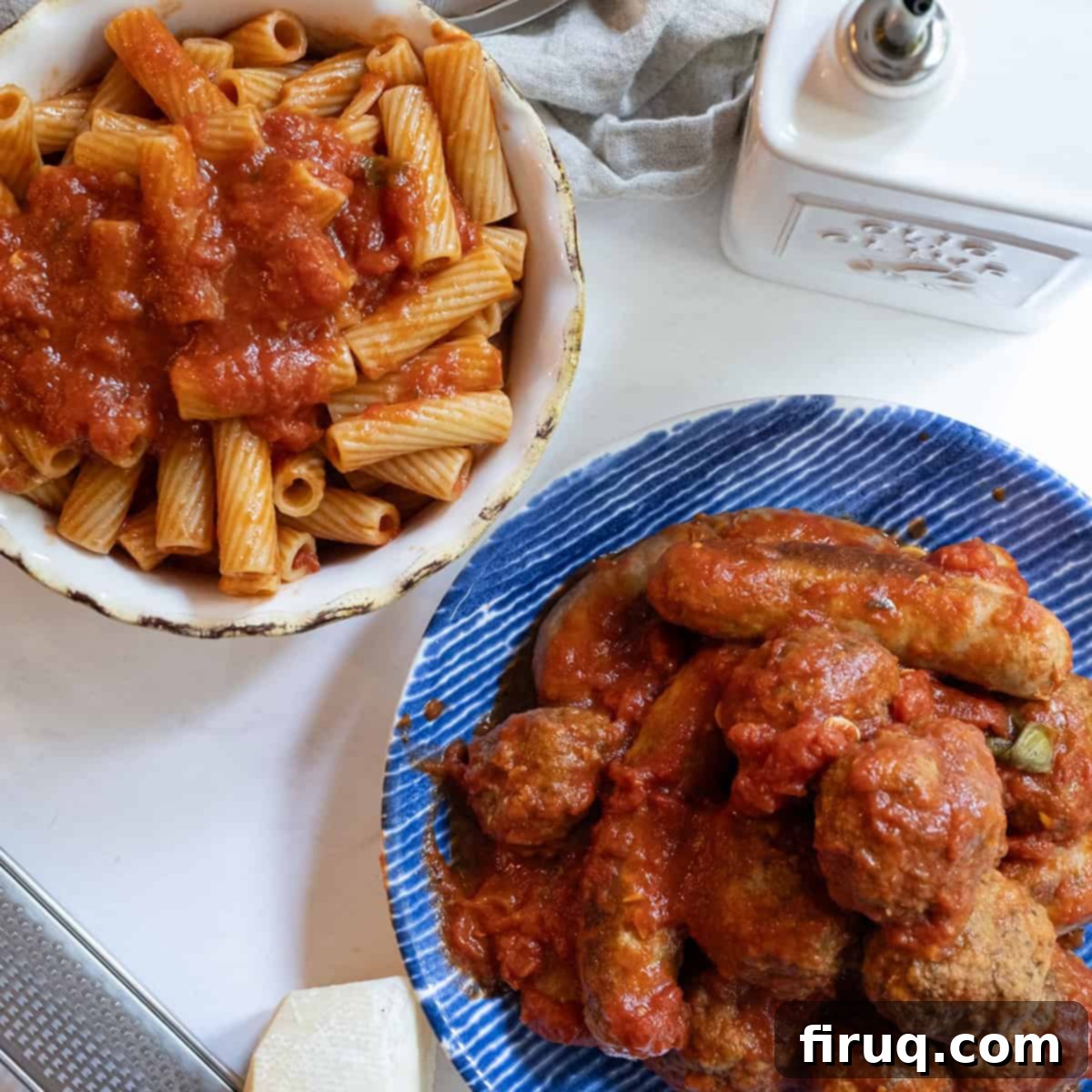
What to Serve with This Authentic Italian Sunday Sauce
A true Authentic Italian Sunday Sauce is a meal in itself, typically served over a generous bed of pasta, with the tender, flavor-infused meatballs and sausages presented alongside. This classic Italian dish brings back cherished memories of home and family. To complete your traditional Sunday feast, here are some of our favorite accompaniments:
- For fresh vegetables, I love pairing it with vibrant Sautéed Rapini with Garlic, crisp Garlic Parmesan Green Beans, or a refreshing Caesar Salad dressed with Traditional Caesar Dressing.
- Don’t forget some crusty Fresh Italian Bread for dipping into that glorious sauce, and perhaps some Crispy Italian Chicken Cutlets for an extra protein option.
- Before the main course, easy Italian appetizers like Eggplant Caponata or Marinated Eggplant and Onion are always a hit.
- To perfectly conclude your Italian dinner, indulge in a classic Italian dessert like a festive Rainbow Cookie Cake or a rich Pistachio Cream Tiramisu!
Essential Meat Recipes for Your Sunday Sauce!
- Classic Italian Fried Meatballs
- How to Make Homemade Italian Sausage
- Authentic Italian Braciole
- Authentic Italian Baked Ziti
For more culinary inspiration, videos, and recipes, be sure to follow us on Instagram @vindelgiudice! And please, leave a comment below and share the “secrets” to your family’s Sunday Sauce – if you’re willing to spill the beans, of course!
📖 Recipe
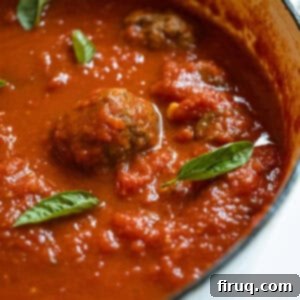
Authentic Italian Sunday Sauce
Vincent DelGiudiceEquipment
-
1 large pot
-
1 immersion blender or blender
Ingredients
- 8 cloves garlic, minced
- 3 tablespoon tomato paste
- 3 24 oz cans san marzano peeled tomatoes
- 9 basil leaves
- 1-2 tablespoon kosher salt
- 10 meatballs
- 6 Italian sausages (hot, sweet, or both)
- 3 tablespoon extra virgin olive oil
- 1 lb pasta
Instructions
-
In a large pot, heat extra virgin olive oil over medium heat. Once hot, stir in the garlic. Stir often for 1 minute. After 1 minute, add tomato paste away from the garlic. Allow the tomato paste to sit while you continue stirring the garlic for 1 more minute.
-
Pour in 3 cans of san marzano tomatoes. Bring the sauce to a simmer. Use the back of the wooden spoon to break apart the tomatoes. It will be easier to do this once they are hot. Stir in the basil and salt and bring the sauce to a simmer.
-
Keep the sauce at a simmer and add your meatballs and sausages typically par-cooked. Allow the sauce to simmer on low for 3 hours.
-
Prepare your choice of pasta. Remove your meatballs and sausage. If you prefer a smoother sauce, now would be the time to pulse the sauce with an immersion blender. Combine sauce with pasta in the pot you cooked the pasta in and serve with fresh parmesan.
Notes
- The true secret to the not-so-secret Sunday sauce is time and patience. Tomatoes have to cook to taste good. These tomatoes you are using are (sort of) raw. They have to completely cook through.
- Stir often to make sure it’s not burning to the bottom of the pot. I haven’t seen wrath quite like my mom the time she asked me to stir the sauce while she was out and I forgot.
- Add salt to taste periodically. Sunday sauce will need more salt as it cooks. Just add a little bit at a time and taste to see how it is.
- When you add the tomato paste, you’re letting it caramelize on the pan to release the flavors and break down some of the natural sugars.
- Don’t add sugar. Cooking the sauce for a long period of time will balance out the acidity.
- Always finish with basil to get the final pop of flavor!
